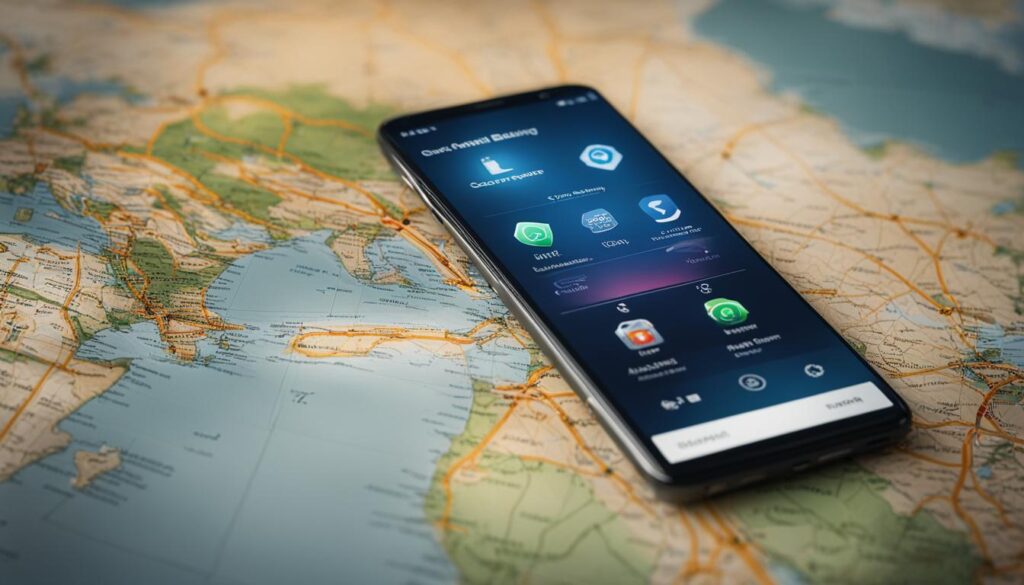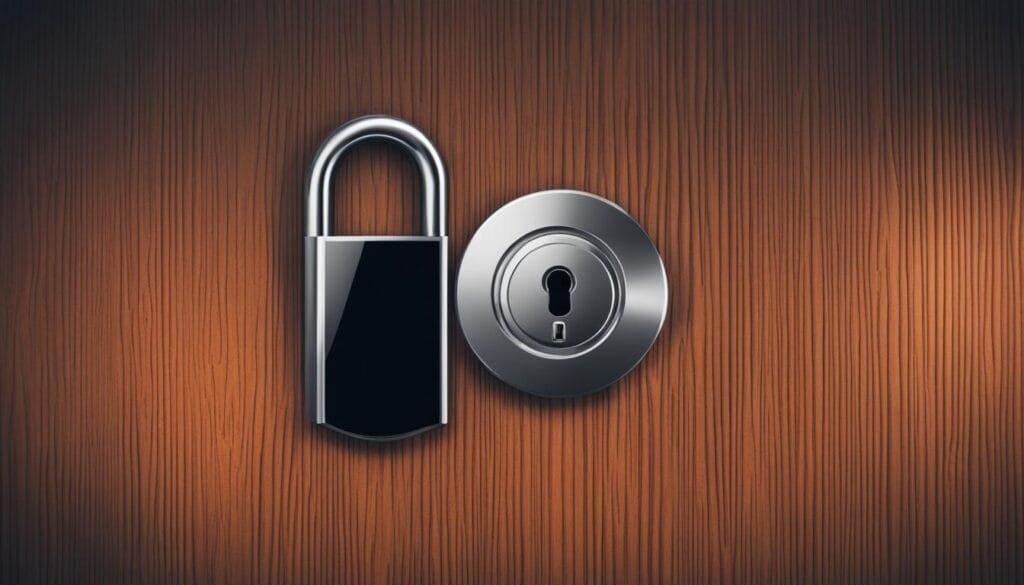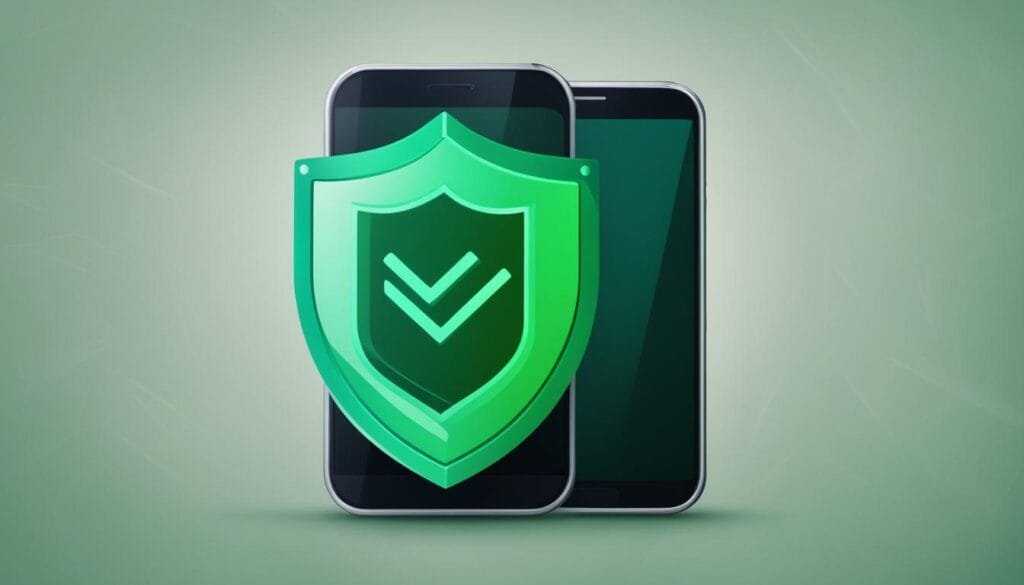Mobile banking has revolutionized the way modern travelers manage their finances, providing convenience and accessibility at their fingertips. However, ensuring security while banking on the go is of utmost importance to protect against potential fraud and unauthorized access to sensitive information.
When engaging in international banking, travelers must be aware of the unique security challenges they may encounter. From accessing foreign networks to utilizing secure mobile banking apps, there are several precautions individuals can take to safeguard their financial transactions while abroad.
Key Takeaways:
- Use secure mobile banking apps and stay updated on security protocols provided by your service provider.
- Avoid using public Wi-Fi networks for financial transactions and opt for secure networks like cellular data or trusted VPNs.
- Download official banking apps from trusted sources and keep them updated with the latest security patches.
- Enable two-factor authentication, avoid saving sensitive information on your device, and regularly monitor your account for suspicious activity.
- Protect your mobile device from malware and viruses through reliable antivirus software and cautious app downloads.
The Risks of Mobile Banking on Foreign Networks
When it comes to mobile banking abroad, it’s crucial to be aware of the risks associated with using foreign networks. Public Wi-Fi networks in popular tourist destinations can be vulnerable to hackers and cybercriminals, putting your financial information at risk. To ensure secure access to your account, it is highly recommended to avoid using public Wi-Fi for any financial transactions.
Instead, opt for more secure networks such as your cellular data plan or a trusted virtual private network (VPN). These options provide encrypted connections that protect your data from potential threats. By using secure networks, you can minimize the risk of your sensitive information being intercepted.
To further enhance your security, consider using two-factor authentication (2FA) when accessing your mobile banking app. This additional layer of protection requires a second form of verification, such as a unique code sent to your phone, to ensure that only you can access your account.
By following these best practices and taking precautions when banking on foreign networks, you can significantly reduce the chances of falling victim to fraud or cyberattacks. Ensure that you prioritize secure access to your accounts to safeguard your financial well-being while traveling.
Secure Mobile Banking Apps for International Transactions
When it comes to global banking and ensuring mobile safety during international transactions, utilizing secure mobile banking apps is a crucial step. These dedicated apps offered by many banks provide enhanced security features that prioritize the protection of sensitive information and financial transactions. With encryption technology and multi-factor authentication, these apps create a secure environment for users.
Downloading official banking apps from trusted sources such as app stores is essential to ensure the authenticity and integrity of the app. By keeping these apps updated with the latest security patches, users can benefit from added protection against potential vulnerabilities. It is crucial to stay vigilant and regularly check for updates to ensure the highest level of security.
Benefits of Secure Mobile Banking Apps
- Encryption Technology: Secure mobile banking apps utilize encryption technology to protect users’ sensitive information. This means that even if someone intercepts the data, it will be unreadable without the decryption key.
- Multi-Factor Authentication: These apps implement multi-factor authentication, adding an extra layer of security by requiring users to provide additional verification, such as a fingerprint or a one-time password, to access their accounts.
- Transaction Monitoring: Secure mobile banking apps often offer real-time transaction monitoring, allowing users to review and monitor their financial activities for any unauthorized or suspicious transactions.
- Secure Communication Channels: These apps establish secure communication channels between the user’s device and the banking system, protecting sensitive data from interception by third parties.
By utilizing secure mobile banking apps for international transactions, individuals can have peace of mind knowing that their financial information is protected. These apps play a significant role in ensuring the safety and security of mobile banking activities no matter where users are in the world.
| Feature | Description |
|---|---|
| Encryption Technology | Utilizes encryption technology to protect sensitive information from unauthorized access or interception. |
| Multi-Factor Authentication | Requires users to provide additional verification, such as a fingerprint or a one-time password, to access their accounts. |
| Transaction Monitoring | Offers real-time transaction monitoring for users to review and monitor their financial activities. |
| Secure Communication Channels | Establishes secure communication channels between the user’s device and the banking system to protect sensitive data. |
With the prevalence of mobile banking and the increasing need for security during international transactions, secure mobile banking apps are the go-to solution for ensuring mobile safety and protecting financial information. By leveraging these apps and their advanced security features, individuals can confidently manage their finances on a global scale.

Best Practices for Secure Mobile Banking on the Go
When it comes to secure mobile banking while traveling, there are several best practices that can help protect your financial information. By following these tips, you can ensure a safer banking experience on the go.
Enable Two-Factor Authentication
One of the most effective ways to enhance the security of your mobile banking app is by enabling two-factor authentication (2FA). This adds an extra layer of protection by requiring a second form of verification, such as a unique code sent to your mobile device or a fingerprint scan. By enabling 2FA, you significantly reduce the risk of unauthorized access to your account.
Avoid Saving Sensitive Information
It’s important to resist the temptation of saving sensitive information like passwords or PINs on your device. While it may be convenient, saving this information increases the risk of it falling into the wrong hands if your device is lost or stolen. Instead, commit important credentials to memory or consider using a secure password manager to store them safely.
Regularly Check for Suspicious Activity
While traveling, it’s crucial to stay vigilant and regularly monitor your bank account for any suspicious activity. Keep an eye out for unfamiliar transactions or unusual changes to your account information. If you notice any discrepancies, report them to your bank immediately. By staying proactive and attentive, you can detect and prevent potential fraudulent activity.
Consider Local SIM Cards to Avoid Data Roaming Charges
When traveling internationally, data roaming charges can quickly add up. To avoid excessive fees, consider purchasing a local SIM card. This allows you to access data at local rates, saving you money while still ensuring a reliable internet connection for secure mobile banking. Before purchasing a local SIM card, check with your service provider to ensure compatibility with your device.
| Best Practices | Benefits |
|---|---|
| Enable Two-Factor Authentication | Enhanced account security |
| Avoid Saving Sensitive Information | Reduced risk of unauthorized access |
| Regularly Check for Suspicious Activity | Early detection and prevention of fraud |
| Consider Local SIM Cards | Cost savings on data roaming charges |
Protecting Your Mobile Device from Malware and Viruses
When it comes to secure mobile banking on the go, protecting your mobile device from malware and viruses is crucial. These threats can compromise the security of your mobile banking activities, putting your sensitive financial information at risk. To ensure the safety of your device, there are several measures you can take.
Firstly, it is essential to have a reliable antivirus software installed on your mobile device. This software will help detect and prevent malware and viruses from infecting your device. Regularly update your antivirus software to stay protected against the latest threats.
It is important to be cautious when downloading apps from unofficial sources. Stick to trusted app stores and only download apps from reputable developers. Malware and viruses often hide within fake or malicious apps, so it is crucial to verify the legitimacy of the sources before downloading.
In addition to having antivirus software, it is important to be mindful of the links and advertisements you interact with on your mobile device. Avoid clicking on suspicious links or ads, as they may lead to websites that contain malware or trick you into providing personal information.
Regularly scanning your device for malware and keeping your operating system updated with the latest security patches are also important steps in protecting your mobile device. These measures help ensure that your device has the latest security features and vulnerabilities are patched.

Table: Mobile Device Security Checklist
| Security Measure | Description |
|---|---|
| Install antivirus software | Choose a reliable antivirus software and keep it updated to protect against malware and viruses. |
| Download apps from trusted sources | Avoid downloading apps from unofficial sources to minimize the risk of malware and viruses. |
| Be cautious of links and ads | Avoid clicking on suspicious links and ads that may lead to malicious websites. |
| Regularly scan for malware | Scan your device regularly to detect and remove any malware or viruses. |
| Keep operating system updated | Regularly update your device’s operating system to ensure you have the latest security patches. |
By following these best practices and implementing strong security measures, you can protect your mobile device from malware and viruses, safeguarding your mobile banking activities while traveling. Stay vigilant and prioritize the security of your device to ensure a safe and secure banking experience.
The Importance of Strong Passwords and Regular Monitoring
When it comes to secure mobile banking, one of the most crucial aspects is the use of strong and unique passwords. It is important to create passwords that are difficult for others to guess, as this adds an extra layer of protection to your accounts. Avoid using common words or personal information in your passwords, and instead opt for a combination of uppercase and lowercase letters, numbers, and special characters.
Additionally, consider using a password manager to securely store and generate complex passwords for your various accounts. A password manager can help you avoid the temptation of using the same password across multiple platforms, which can greatly increase your vulnerability to cyberattacks. By utilizing strong passwords and a password manager, you can significantly enhance the security of your mobile banking activities.
In addition to strong passwords, regular monitoring of your bank statements and account activity is essential for maintaining the security of your mobile banking transactions. By keeping a close eye on your financial transactions, you can quickly detect any unauthorized activity or suspicious charges. If you notice anything unusual, it is important to report it to your bank immediately to prevent any further fraudulent activity.
| Password Security Tips | Account Monitoring Best Practices |
|---|---|
|
|
By following these password security tips and practicing regular account monitoring, you can significantly reduce the risk of unauthorized access to your mobile banking accounts. Protecting your financial information is of utmost importance, and these simple steps can go a long way in ensuring the security of your mobile banking activities.
Conclusion
In conclusion, secure mobile banking is paramount for modern travelers. By following best practices such as using secure networks, downloading official banking apps, and practicing good password hygiene, individuals can protect their financial information while managing their finances abroad. It is essential to stay vigilant and regularly update security measures to stay one step ahead of potential threats.
When banking on foreign networks, it is important to be aware of the risks associated with public Wi-Fi. To mitigate these risks, it is recommended to use secure networks such as your cellular data plan or a trusted VPN. Avoid using public Wi-Fi for financial transactions to ensure secure access to your account.
Additionally, protecting your mobile device from malware and viruses is crucial. Install reliable antivirus software, be cautious when downloading apps from unofficial sources, and regularly scan your device for malware. Keeping your operating system updated with the latest security patches is also essential.
Remember that secure mobile banking starts with creating strong and unique passwords. Avoid easily guessable passwords and consider using a password manager to securely store your credentials. Regularly monitor your bank statements and account activity for any unauthorized transactions, and report any suspicious activity to your bank immediately.
FAQ
Is mobile banking safe when traveling abroad?
Mobile banking can be safe when traveling abroad if certain security measures are followed, such as using secure networks and downloading official banking apps.
What risks are associated with mobile banking on foreign networks?
Public Wi-Fi networks in tourist destinations can be vulnerable to hackers and cybercriminals, putting your financial information at risk.
How can I protect my mobile banking activities on foreign networks?
To protect your mobile banking activities on foreign networks, it is recommended to use secure networks like your cellular data plan or a trusted virtual private network (VPN).
Are there dedicated mobile banking apps for international transactions?
Yes, many banks offer dedicated mobile banking apps that provide enhanced security features for international transactions, such as encryption technology and multi-factor authentication.
What are some best practices for secure mobile banking on the go?
Best practices for secure mobile banking on the go include enabling two-factor authentication, avoiding saving sensitive information on your device, and using secure networks whenever possible.
How can I protect my mobile device from malware and viruses?
To protect your mobile device from malware and viruses, ensure that you have reliable antivirus software installed, avoid downloading apps from unofficial sources, and regularly scan your device for malware.
How important are strong passwords and regular monitoring for secure mobile banking?
Strong passwords and regular monitoring are essential for secure mobile banking. Create strong and unique passwords, regularly monitor your bank statements, and report any suspicious activity immediately.
What Are the Best Practices for Ensuring Security When Integrating Fintech with Mobile Banking?
When integrating fintech with mobile banking, implementing secure fintech integration strategies is crucial. It is vital to conduct thorough risk assessments, employ strong authentication methods, and regularly update security measures. Additionally, utilizing encrypted data transmission and monitoring financial transactions help safeguard against potential security breaches, ensuring a safe and seamless experience for users.


Pingback: Banking on Security: Best Practices for Secure Mobile Banking – Straight Fire Money